| Mission type | Mars impactor |
|---|---|
| Operator | Washington State University |
| Mission duration | At Mars: 10 Sols (≈11 Earth days) |
| Mars impactor | |
The Biological Oxidant and Life Detection (BOLD) is a concept mission to Mars focused on searching for evidence or biosignatures of microscopic life on Mars. [1] [2] [3] [4] The BOLD mission objective would be to quantify the amount of hydrogen peroxide (H
2O
2) existing in the Martian soil and to test for processes typically associated with life. Six landing packages are projected to impact 'softly' on Mars that include a limited power supply, a set of oxidant and life detection experiments, and a transmitter, which is able to transmit information via an existing Mars orbiter back to Earth. The mission was first proposed in 2012. [5]
The Viking program to Mars was the only mission to date that conducted life-detection experiments. It revealed ambiguous and still controversial results. The mission proponents argue that new findings and hypotheses urge a re-evaluation of the Viking results and a re-evaluation of the evidence for the possible presence of life on Mars in general. [2] Recent and current missions to be launched focus on habitability considerations (e.g., Phoenix, Mars Science Laboratory), but shy away from directly testing for life on Mars, with the potential exception of the ESA ExoMars mission.
The BOLD mission is designed to be less expensive than most current Mars missions as it consists only of a carrier vehicle with 6 probes attached. No orbiter is assumed. Instead the probes take advantage of existing Mars orbiters for communications relay. The number of probes is intended to provide a certain degree of mission redundancy in case some of them do not land successfully or fail.
The scientific objectives of the BOLD mission are: to identify the unknown oxidant in the Martian soil, which was postulated after the Viking program, and to probe whether there is extant life near the Martian surface. In contrast to the Viking mission, which was geared toward finding abundant heterotrophic life on Mars with a global distribution, the BOLD mission is aimed at a more comprehensive search including lithoautrophic and photosynthetic microbes, and a variety of biosignatures. [2]
If selected and funded, the carrier vehicle with the landing probes would be propelled into a circular orbit around Mars. The orbiter would be equipped with a small solid rocket to provide the deceleration required to insert the spacecraft in an entry trajectory that can safely release the probes on the Martian surface. A terrain navigation system, coupled with robust propulsion, potentially permits targeting with precision on the order of meters if required to meet the science objectives. Each probe would have a mass of 59 kilograms (130 pounds) [3] with a science payload of less than 10 kilograms (22 lb). Each of the probes' lander system uses a parachute and a crushable shell behind the heat shield for a 'soft impact' landing. Upon landing, the science instruments at their tips would penetrate up to 30 centimeters (one foot) into Martian regolith, a depth sufficient to conduct accurate scientific measurements. [3] The landing probes will be powered by batteries. The mission duration for each landing probe is anticipated to be 10 sols (10 Martian days). [2]
The envisioned instrument suite on each probe includes: [1] [2]
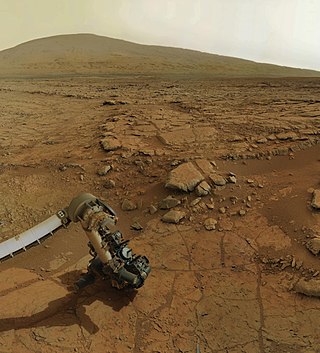
Astrobiology is a scientific field within the life and environmental sciences that studies the origins, early evolution, distribution, and future of life in the universe by investigating its deterministic conditions and contingent events. As a discipline, astrobiology is founded on the premise that life may exist beyond Earth.
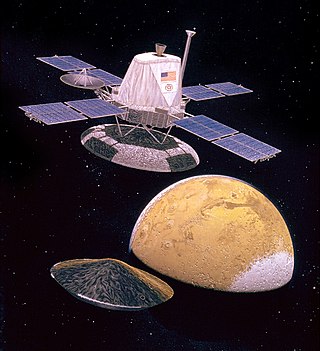
The Viking program consisted of a pair of identical American space probes, Viking 1 and Viking 2, which landed on Mars in 1976. The mission effort began in 1968 and was managed by the NASA Langley Research Center. Each spacecraft was composed of two main parts: an orbiter designed to photograph the surface of Mars from orbit, and a lander designed to study the planet from the surface. The orbiters also served as communication relays for the landers once they touched down.
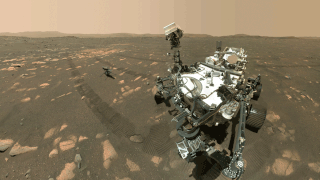
The planet Mars has been explored remotely by spacecraft. Probes sent from Earth, beginning in the late 20th century, have yielded a large increase in knowledge about the Martian system, focused primarily on understanding its geology and habitability potential. Engineering interplanetary journeys is complicated and the exploration of Mars has experienced a high failure rate, especially the early attempts. Roughly sixty percent of all spacecraft destined for Mars failed before completing their missions, with some failing before their observations could begin. Some missions have been met with unexpected success, such as the twin Mars Exploration Rovers, Spirit and Opportunity, which operated for years beyond their specification.
The possibility of life on Mars is a subject of interest in astrobiology due to the planet's proximity and similarities to Earth. To date, no conclusive evidence of past or present life has been found on Mars. Cumulative evidence suggests that during the ancient Noachian time period, the surface environment of Mars had liquid water and may have been habitable for microorganisms, but habitable conditions do not necessarily indicate life.
A biosignature is any substance – such as an element, isotope, molecule, or phenomenon – that provides scientific evidence of past or present life on a planet. Measurable attributes of life include its physical or chemical structures, its use of free energy, and the production of biomass and wastes.

In 1976 two identical Viking program landers each carried four types of biological experiments to the surface of Mars. The first successful Mars landers, Viking 1 and Viking 2, then carried out experiments to look for biosignatures of microbial life on Mars. The landers each used a robotic arm to pick up and place soil samples into sealed test containers on the craft.
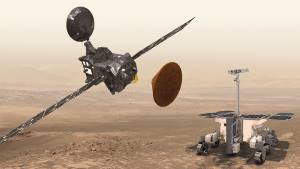
ExoMars is an astrobiology programme of the European Space Agency (ESA).

Planetary protection is a guiding principle in the design of an interplanetary mission, aiming to prevent biological contamination of both the target celestial body and the Earth in the case of sample-return missions. Planetary protection reflects both the unknown nature of the space environment and the desire of the scientific community to preserve the pristine nature of celestial bodies until they can be studied in detail.

The Astrobiology Field Laboratory (AFL) was a proposed NASA rover that would have conducted a search for life on Mars. This proposed mission, which was not funded, would have landed a rover on Mars in 2016 and explore a site for habitat. Examples of such sites are an active or extinct hydrothermal deposit, a dry lake or a specific polar site.

EXPOSE is a multi-user facility mounted outside the International Space Station (ISS) dedicated to astrobiology. EXPOSE was developed by the European Space Agency (ESA) for long-term spaceflights and was designed to allow exposure of chemical and biological samples to outer space while recording data during exposure.
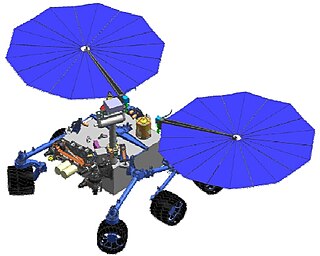
The Mars Astrobiology Explorer-Cacher (MAX-C), also known as Mars 2018 mission, was a NASA concept for a Mars rover mission, proposed to be launched in 2018 together with the European ExoMars rover. The MAX-C rover concept was cancelled in April 2011 due to budget cuts.

Dirk Schulze-Makuch is a professor at the Center for Astronomy and Astrophysics at Technische Universität Berlin, Germany and adjunct professor at the School of Earth and Environmental Sciences Washington State University, Pullman, Washington. He is best known for his publications on extraterrestrial life, being coauthor of five books on the topic: The Cosmic Zoo: Complex Life on Many Worlds (2017), A One Way Mission to Mars: Colonizing the Red Planet (2011), We Are Not Alone: Why We Have Already Found Extraterrestrial Life (2010), Cosmic Biology: How Life could Evolve on Other Worlds (2010), and Life in the Universe: Expectations and Constraints. In 2012 he published with David Darling Megacatastrophes! Nine Strange Ways the World Could End. In 2013 he published the second edition of his science fiction novel Alien Encounter. Together with Paul Davies he proposed in 2010 exploration of Mars by a one-way trip to the planet.
Interplanetary contamination refers to biological contamination of a planetary body by a space probe or spacecraft, either deliberate or unintentional.
Rosalind Franklin, previously known as the ExoMars rover, is a planned robotic Mars rover, part of the international ExoMars programme led by the European Space Agency and the Russian Roscosmos State Corporation. The mission was scheduled to launch in July 2020, but was postponed to 2022. The Russian invasion of Ukraine has caused an indefinite delay of the programme, as the member states of the ESA voted to suspend the joint mission with Russia; in July 2022, ESA terminated its cooperation on the project with Russia. As of May 2022, the launch of the rover is not expected to occur before 2028 due to the need for a new non-Russian landing platform.

Icebreaker Life is a Mars lander mission concept proposed to NASA's Discovery Program. The mission involves a stationary lander that would be a near copy of the successful 2008 Phoenix and InSight spacecraft, but would carry an astrobiology scientific payload, including a drill to sample ice-cemented ground in the northern plains to conduct a search for biosignatures of current or past life on Mars.
ExoLance is a low-cost mission concept that could hitch a ride on other missions to Mars in an effort to look for evidence of subsurface life.

The Urey instrument, or Urey: Mars Organic and Oxidant Detector was a developmental spacecraft instrument for detecting organic compounds including amino acids.
Signs Of LIfe Detector (SOLID) is an analytical instrument under development to detect extraterrestrial life in the form of organic biosignatures obtained from a core drill during planetary exploration.